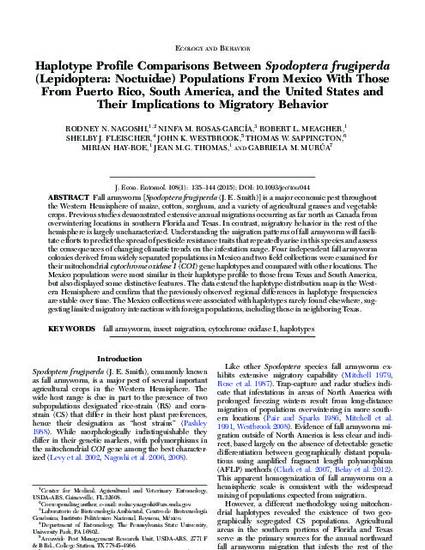
Fall armyworm [Spodoptera frugiperda (J. E. Smith)] is a major economic pest throughout the Western Hemisphere of maize, cotton, sorghum, and a variety of agricultural grasses and vegetable crops. Previous studies demonstrated extensive annual migrations occurring as far north as Canada from overwintering locations in southern Florida and Texas. In contrast, migratory behavior in the rest of the hemisphere is largely uncharacterized. Understanding the migration patterns of fall armyworm will facilitate efforts to predict the spread of pesticide resistance traits that repeatedly arise in this species and assess the consequences of changing climatic trends on the infestation range. Four independent fall armyworm colonies derived from widely separated populations in Mexico and two field collections were examined for their mitochondrial cytochrome oxidase I (COI) gene haplotypes and compared with other locations. The Mexico populations were most similar in their haplotype profile to those from Texas and South America, but also displayed some distinctive features. The data extend the haplotype distribution map in the Western Hemisphere and confirm that the previously observed regional differences in haplotype frequencies are stable over time. The Mexico collections were associated with haplotypes rarely found elsewhere, suggesting limited migratory interactions with foreign populations, including those in neighboring Texas.
Available at: http://works.bepress.com/thomas_sappington/105/

This is an article from Nagoshi, Rodney N., Ninfa M. Rosas-García, Robert L. Meagher, Shelby J. Fleischer, John K. Westbrook, Thomas W. Sappington, Mirian Hay-Roe, Jean MG Thomas, and Gabriela M. Murúa. "Haplotype profile comparisons between Spodoptera frugiperda (Lepidoptera: Noctuidae) populations from Mexico with those from Puerto Rico, South America, and the United States and their implications to migratory behavior." Journal of economic entomology 108, no. 1 (2015): 135-144. doi: 10.1093/jee/tou044. Posted with permission.